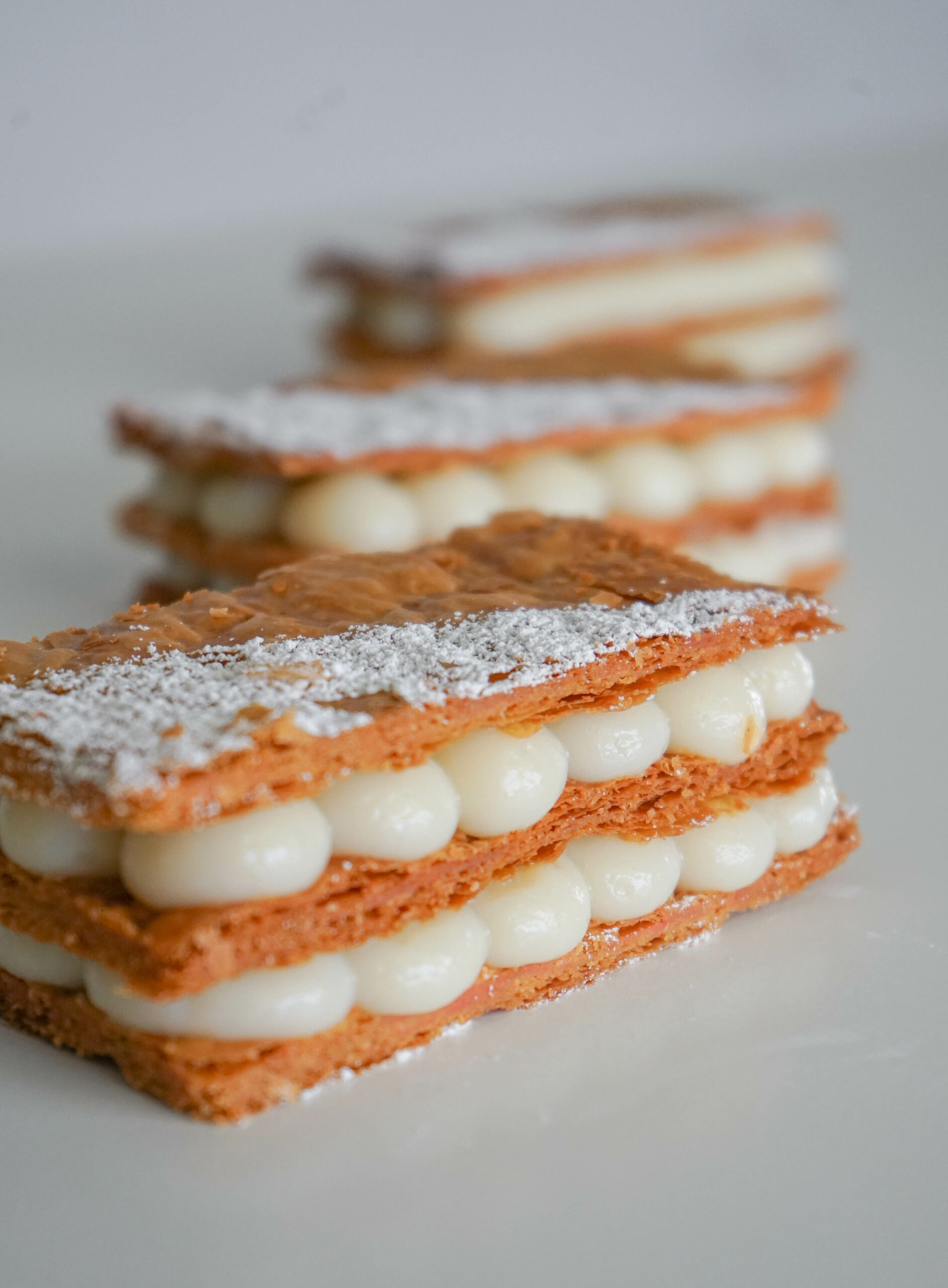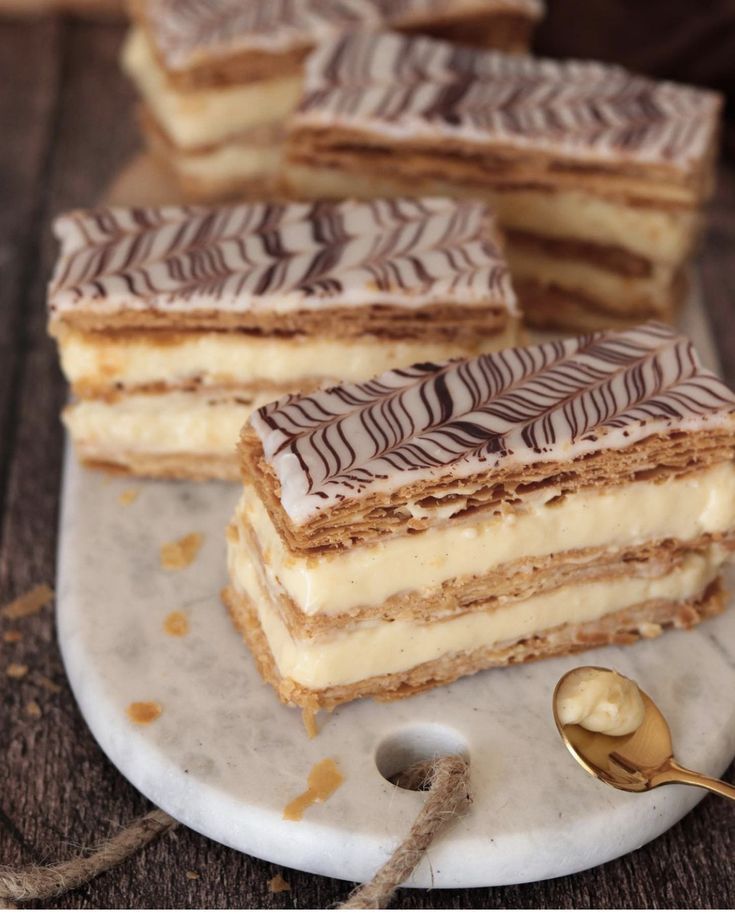The Classic Mille-Feuilles Recipe – A Timeless French Dessert
No matter where you are in the world, you’ve probably heard of this iconic French dessert: the Mille-feuilles.
Also known as Napoleon or vanilla slice in different parts of the world, the concept remains the same:
Crispy, buttery puff pastry layered with delicate vanilla pastry cream and traditionally topped with a shiny fondant icing.
Confession time: I’m not a big fan of icing… so you won’t see any on the pictures in this post! 🙈
That said, this is one of the most elegant and versatile pastries you can master. Today, I’m sharing the classic vanilla version, but once you know the technique, the possibilities for flavor variations—fruits, spices, or even chocolate—are endless!
Traditionally served as individual portions, Mille-feuilles can also be scaled up into a large dessert to share or even made into oversized versions for events like birthdays or weddings.
Servings
6
Prep time:
30min
Cook time:
30min
Resting time:
1h30
Why You Should Bake This Classic Mille-Feuilles Recipe
If you’re ready to elevate your baking skills, this French classic is the perfect next step.
It only consists of two main elements—puff pastry and pastry cream—but the result is incredibly refined.
It’s a wonderful way to serve a beautiful, elegant dessert without feeling overwhelmed by complex techniques.
Once you’ve mastered the basic method, it’s easy to customize the flavors and presentation.
From traditional stacks to deconstructed plating, the Mille-feuilles allows for creativity and personal style.

Ingredients
Puff Pastry
(follow the recipe here)
- 250g all-purpose flour
- 200g cold unsalted butter (cut into chunks)
- 1/4 teaspoon salt
- 100g cold water
Vanilla Pastry Cream
- 500g whole milk
- 2 eggs
- 150g granulated sugar
- 40g cornflour (cornstarch)
- 1 vanilla bean or high-quality vanilla extract
Step by Step Instructions
Bake the Puff Pastry
If you’re not making your own puff pastry, at least buy it from a good bakery. Store-bought versions often use margarine or palm oil instead of real butter, which affects both taste and texture.
- Roll out your puff pastry to fit your baking tray.
- Prick the dough with a fork to prevent excessive rising.
- Place a second baking tray directly on top to keep the layers flat and even while baking.
- Bake at 180°C (356°F) for 30 minutes, removing the top tray during the last 5 minutes for a golden finish.
- Allow to cool completely on a wire rack before slicing.
Prepare the Vanilla Pastry Cream
- Split your vanilla bean and scrape out the seeds.
- Place both the seeds and pod in a saucepan with the milk and heat gently. Allow to infuse for 20–30 minutes.
- In a separate bowl, whisk together the eggs, sugar, and cornflour.
- Remove the vanilla pod from the milk, then slowly pour half the warm milk into the egg mixture, whisking constantly.
- Return the mixture to the saucepan and cook over medium heat, whisking continuously until the cream thickens.
- Transfer to a clean bowl, cover with plastic wrap directly touching the surface (this prevents a skin from forming), and let it cool completely.
Assemble the Mille-Feuilles
- Divide your baked puff pastry into equal-sized rectangles—you’ll need three per portion.
- Place the vanilla cream into a piping bag for precision.
- Start by piping the cream onto the first pastry layer.
- Gently place the second pastry sheet on top. For evenness, pipe a bit of cream in the corners before continuing across the surface.
- Repeat with the third and final layer.
- Dust with icing sugar or apply fondant icing (see below) before serving.

What Is Traditional Mille-Feuilles Icing and How to Use It?
Traditional icing for Mille-feuilles is called “fondant”, a smooth, white glaze made from sugar syrup, glucose syrup, and water.
It’s commonly decorated with chocolate lines swirled into a feathered pattern.
Fondant is also used for other French pastries like eclairs and religieuses, and can be flavored with chocolate or coffee depending on the dessert.
How to Use Fondant Icing Properly
- Heat gently to 35–37°C (95–98.6°F) using a bain-marie for the right consistency and shine.
- Ice your top pastry layer before assembling the Mille-feuilles to ensure a clean and stable finish.
- Allow to dry before serving.

The “traditional” look
Frequently Asked Questions
How can I store Mille-feuilles, and for how long?
Store in the fridge, covered, for up to 2 days. Best enjoyed the same day for optimal texture.
Can I freeze vanilla slices?
It’s not recommended. Puff pastry can become soggy once thawed, and the cream may separate.
Where can I buy fondant?
Specialty baking stores or online pastry supply shops. Look for “pâtisserie fondant” specifically.
Can I use store-bought puff pastry?
Yes, but choose one made with real butter for the best flavor and texture. Ideally buy one directly from your local bakery.
What are the other names for Mille-feuilles?
Depending on the region, it’s also known as:
- Napoleon
- Vanilla slice
- Crème pâtissière slice
More recipes to explore after the Classic Mille-Feuille
Now that you’ve learned how to make this iconic dessert, why not try other classics?
Fraisier Cake
The elegant strawberry layer cake that captures the taste of French spring.
Chocolate Mousse
A silky-smooth classic that delivers rich flavor with minimal ingredients.
Pear Frangipane Tart
A rustic yet refined dessert of juicy pears nestled in almond cream.
If you want to take things further, explore our Online Pastry Courses to master more French classics from your own kitchen.

YOUR FREE EBOOK!
- 14 free pages full of advices to master the art of French tarts.
- Our « Foolproof » pie crust recipe
- 5 delicious tart recipes to use it
- A delicious salty version: The French Quiche






